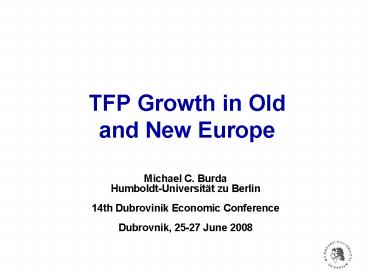TFP Growth in Old and New Europe - PowerPoint PPT Presentation
1 / 27
Title:
TFP Growth in Old and New Europe
Description:
Title: Anatomie eines Aufschwungs Author: burda Last modified by: hnb Created Date: 9/2/2001 7:43:10 PM Document presentation format: Projekcija na zaslonu – PowerPoint PPT presentation
Number of Views:53
Avg rating:3.0/5.0
Title: TFP Growth in Old and New Europe
1
TFP Growth in Old and New Europe
- Michael C. Burda
- Humboldt-Universität zu Berlin
- 14th Dubrovinik Economic Conference
- Dubrovnik, 25-27 June 2008
2
Summary
- The European Integration Episode and Paths of
Integration - TFP and Measurement Issues
- Alternative TFP measurements in Old and New
Europe - Findings
3
The Great European Integration Episode
- How to achieve most efficient use of resources
among the European regions? - Solow growth
- Migration
- Capital mobility
- Factor proportions (Heckscher-Ohlin) trade
- Adoption of leading edge technologies
- Elimination of inefficiencies establishment of
property rights and rule of law
4
TFP and Measurement Issues
- Remember Ultimately, growth in total factor
productivity (TFP) is the source of all per
capita economic growth - The role of product and labor market regulations
for the form and speed of implementation of new
innovations, especially ICT (van Ark et al. 2008)
5
Old Europe v. New Europe
Now, you're thinking of Europe as Germany and
France. I don't. I think that's old Europe. If
you look at the entire NATO Europe today, the
center of gravity is shifting to the east. And
there are a lot of new members. And if you just
take the list of all the members of NATO and all
of those who have been invited in recently --
what is it? Twenty-six, something like that? --
you're right.
6
Old Europe v. New Europe
- Cost of starting businesses, regulation
- Employment protection, firing costs
- Result Different internet penetration levels,
ICT adoption, especially in retail services,
communication, business services - Old Europe v. New Europe
- What about Central and Eastern Europe?
7
Old Europe v. New Europe
- 29 countries
- Old EuropeAustria, Belgium, France, Germany,
Greece, Italy, Portugal, Spain, Switzerland - New EuropeDenmark, Finland, Ireland,
Netherlands, Norway, Sweden, UK - Eastern (CEE) EuropeAlbania, Bulgaria,Croatia
Czech Republic, Estonia,Hungary,Lithuania,Latvia,
Russia, Slovakia, Slovenia, Poland, Romania - US, other OECD excluded
8
Measurement of TFP Growth
- Solow residual measure of TFP growth
- In words Whats left of real growth after
observable reasons for growth are subtracted - Problems with Solow residual Capital stock
measurement (Burda/Severgnini 2008)
9
Capital Stock Measurement
Capital stock Never really observed
Starting condition a wild guess
10
(No Transcript)
11
Synthetic Data DSGE Model
Households choose sequences of consumption, labor
supply, future capital and current utilization of
existing capital to maximize expected utility
subject to K0 given and, for t?0
Firms maximize profits, renting capital and
hiring labor supplied by the households using a
standard neoclassical CRS production
function Equilibrium achieves the social
planners optimum
12
(No Transcript)
13
Measurement error Results from a Monte-Carlo
Study
RMSE
RMSE
Sample Size (quarters)
Sample Size (quarters)
RMSE
RMSE
Sample Size (quarters)
Sample Size (quarters)
Source Burda/Severgnini (2008)
14
Measurement of TFP Growth
- General idea Can we remove capital entirely from
the calculation? - Two proposed solutions
- Direct Substitution
- Generalized Differences (recursive)
TFP growthDS
TFP growthGD
15
(No Transcript)
16
(No Transcript)
17
Summary Averages of TFP Growth Estimates
1994-2003 1994-2003 1994-2003 1998-2003 1998-2003 1998-2003
ST DS GD ST DS GD
Old Europe 0.1 0.2 0.7 0.1 -0.2 0.6
New Europe 0.8 1.3 1.1 0.6 0.7 0.9
CEE 2.8 3.0 2.1 3.7 3.5 2.4
18
Summary Standard Deviation of TFP Growth
Estimates
1994-2003 1994-2003 1994-2003 1998-2003 1998-2003 1998-2003
ST DS GD ST DS GD
Old Europe 0.6 0.6 0.3 0.9 1.0 0.5
New Europe 0.9 1.0 0.5 1.0 1.2 0.6
CEE 1.7 2.0 1.0 1.9 2.0 1.0
19
(No Transcript)
20
(No Transcript)
21
(No Transcript)
22
(No Transcript)
23
Summary of Results
- Impact effect of PMR on TFP growth is always
negative - Impact effect of EPL on TPF growth is always
insignificant - Long-run effect of both PMR and EPL on TFP is
always negative, not always significant - Interactions not significant
- More to be done, but consistent with evidence of
Nicoletti and Scarpetta and others
24
Old Europe v. New Europe
- World Bank Project Doing Business around the
World Starting a business indicators
Number of procedures Durations in days for approval Cost in GNI per capita
Avg. Old Europe 8.25 20.25 9.75
Avg. New Europe 4.89 12.78 1.98
25
Old Europe v. New Europe
- World Bank Project Doing Business around the
World Starting a business indicators
Number of procedures Durations in days for approval Cost in GNI per capita
Avg. Old Europe 8.25 20.25 9.75
Avg. New Europe 4.89 12.78 1.98
Avg. CEE Europe 8.27 29.82 10.2
26
Old Europe v. New Europe
- World Bank Project Doing Business around the
World Starting a business indicators
Number of procedures Durations in days for approval Cost in GNI per capita
Avg. Old Europe 8.3 20.3 9.8
Avg. New Europe 4.9 12.8 2.0
Avg. CEE Europe 8.3 29.8 10.2
Croatia 8 40 11.1
Estonia 5 7 2.0
27
Conclusions
- Large TFP growth gains in CEE, against trend of
both Old and New Europe - Should be interpreted as low-lying fruit after
transformation, moving to the frontier - Quo vadis, Central and Eastern Europe?
- Benefit of competition via entry from established
(Old and New) European firms - Backwash to Old Europe? Lets hope so































